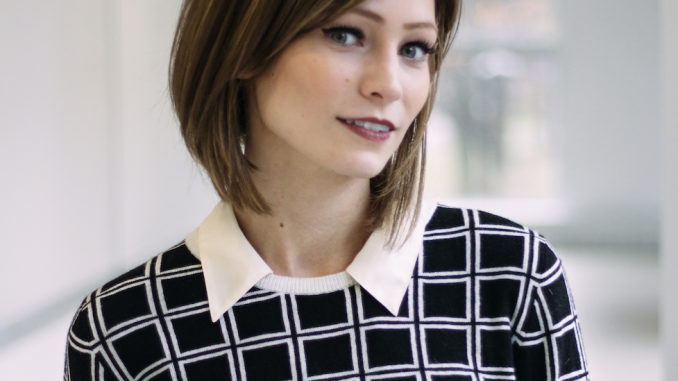
Twenty-one year old Abby Shaffer has spent the majority of her life wearing wigs: from long hair to short hair, the darkest brown to the lightest blonde, curly to straight.
When the fourth-year digital media production and creative writing major was about three years old, her hair began to fall out, right around the time her parents were getting divorced. She speculates that while she was not necessarily cognizant of this happening, she was able to sense the stress going on around her.
This was when she developed alopecia areata. According to the National Alopecia Areata Foundation (NAAF), this is a common autoimmune skin disease that causes hair loss on the scalp, face and sometimes other areas of the body. It often appears during childhood and affects as many as 6.8 million people in the United States.
Shaffer says that her hair comes and goes in waves: some days she wakes up with more hair than others; but other times it seems to disappear overnight.
Each morning she has the routine of putting on her wig, drawing on her eyebrows and for special occasions, putting on fake eyelashes. But until the age of seven, she wore hats.
“When I was really young, I didn’t think about it at all,” she tells me. “But when I got to middle school and high school, I became more self conscious and would only wear one wig. I would tell people that it was my real hair if they asked.”
In ninth grade, Shaffer started to wear more realistic wigs, much more expensive than the ones she would wear previously. Her professional wigs cost her between $200-300, she says, and should be replaced every six months when the ends start to get messy and frayed.
Wearing wigs helped Shaffer cope with her alopecia. They helped her feel more normal. But her anxiety still persisted. During high school, she could hardly mutter the word “alopecia” without getting emotional.
During the summer of 2014, she attended a seminar in New York City that allowed those attending to confront issues of insecurity and other obstacles in their lives. People would go up to the microphone and go through their struggles with a coach; Shaffer wanted to give it a shot.
“I thought when I got up to the microphone I would just be able to talk about my alopecia,” she tells me, grimacing at the memory. “But I immediately started crying and I couldn’t stop. This was when I realized how much it had been affecting me.”
The coach calmed her down and eventually convinced her to tackle her alopecia-induced anxiety by taking off her wig in front of the 300 or so people there. People came up to Shaffer afterwards to tell her how brave she was and how much she inspired them. This was the beginning of a very important transition for her.
In May of 2015, Shaffer started vlogging about alopecia and wigs on YouTube. She had made and edited videos in high school, but as a digital media production major, she wanted to expand her portfolio by creating something more professional.
Her most viewed video is entitled “Dating With Alopecia,” which has reached 11,137 views in under a year. She says this is a common worry for people with alopecia. Creating the video helped her as well, as it is a topic she is currently dealing with herself.
“If [the person you’re dating] doesn’t necessarily know that you’re wearing a wig, you may wonder how they are going to react. In theory, it’s scary,” she says.
After making her first-ever video about tips on selecting wigs for alopecia, Shaffer’s mother shared it on Facebook. In turn, a friend of Shaffer’s mother sent the video to the wig company she wears and raves about: Aderans Co., Ltd, which has three lines of women’s wigs including Noriko, René of Paris and Amore.
Shaffer quickly learned that opening up about her alopecia in public and exposing herself to Aderans would present her with exciting, new opportunities. Now, Shaffer is paid to create reviews of their wigs, which they send her whenever they come out with new releases, and occasionally appears in company catalogs. In late January, she had the opportunity to model for the Amore catalog, which markets itself toward women with hair loss looking for chic, comfortable, professional wigs. The company flew her out to Los Angeles, California for four days and paid for everything per diem. In the future, the company wants her to speak at events such as alopecia conferences, which Shaffer says she is excited about.
“I was so scared to open up about alopecia, but that’s what opened up so many opportunities for me,” she tells me, eyes wide and sparkling. “I’m able to help others who are starting to lose their hair and help them get through it.”
Shaffer says that the next step for her is going bald in public. She has posted pictures of herself without a wig on Facebook and has also made videos where she is sporting a mostly bald head. She says this is very empowering, though terrifying. But she learned that rather than being quick to judge, people are more often eager to be supportive.
“Making videos helps me realize that it’s not about me,” she says. “I can use my experiences to help other people who are also going through the same thing. It gets me out of my own head to realize that there’s a much bigger picture here.”
On Dec. 2, Shaffer will be presenting her senior thesis on how bald women are portrayed in the media in the Honors Center from 3:45 to 4 p.m. To check out Shaffer’s vlog online, go to youtube.com/abbyshaffer, or YouTube channel, @AbbyAndrew.
